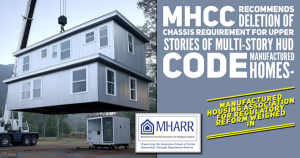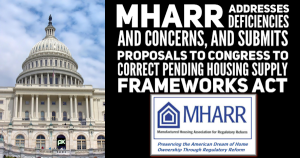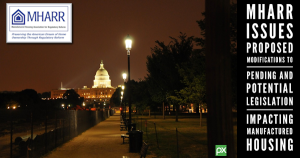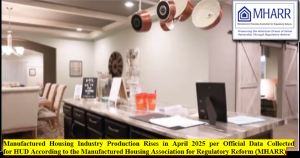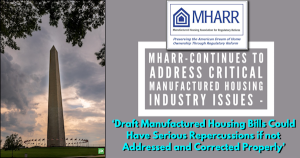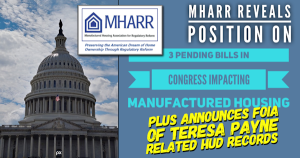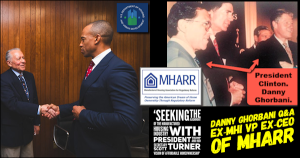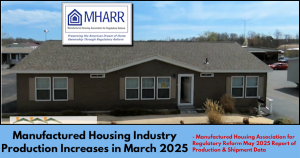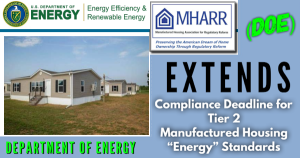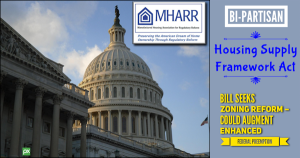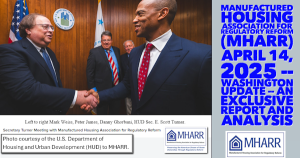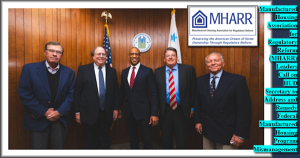HUD Issues New and Revised Manufactured Housing Standards While Dodging Regulatory Reform
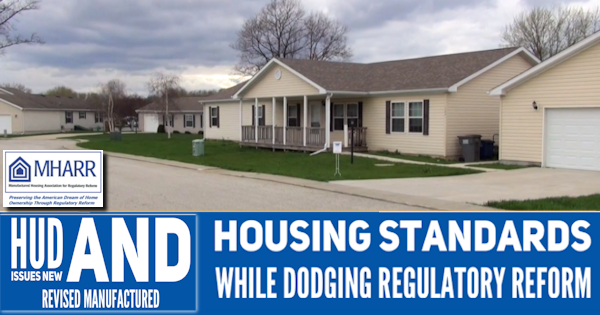
Washington, D.C., January 14, 2021 – The U.S. Department of Housing and Urban Development (HUD) has published, as a final rule, the so-called “third set” of new and revised Federal Manufactured Housing Construction and Safety Standards recommended by the statutory Manufactured Housing Consensus Committee (MHCC). While these standards, which were generally supported by MHARR in written comments filed on March 30, 2020, address a number of longstanding industry concerns, including issues prioritized and advanced by MHARR, HUD’s final rule, with just one week remaining before the January 20, 2021 change in administrations, does not address any of the necessary and far-reaching regulatory reform proposals recommended by the MHCC during a series of marathon meetings in 2019 and early 2020. The rule, accordingly, is arguably more notable for what it excludes, rather than what it includes.
Among other things, the HUD rule, published in the Federal Register on January 12, 2021, with an effective date of March 15, 2021, establishes new standards for attached garages and carports. Such garages and carports had been subject of sub-regulatory HUD “guidance” memoranda — which MHARR consistently maintained were unlawful in violation of the 2000 reform law’s mandatory MHCC review and notice and comment requirements — as well as program approval based on the lengthy and unduly burdensome Alternate Construction (AC) process. In addition to these provisions, the January 12, 2021 rule also establishes new requirements for Carbon Monoxide alarms, as well as standards relating to stairways and doors.
Also, among the new standards adopted by the rule, is a new Subpart K of the Part 3280 standards, for “attached” or “zero-lot-line” manufactured homes, defined as “Two or more adjacent manufactured homes that are structurally independent from foundation to roof and with open space on at least two sides, but which have the appearance of a physical connection….” While MHARR, in its written comments, had generally supported this expansion of permissible manufactured home designs, it questioned the motives behind HUD’s sudden impulse to resurrect this particular MHCC proposal, which dates back to 2006, without simultaneously taking action to advance a potentially much more significant and more recent proposal advanced by MHARR and recommended by the MHCC, to permit and establish standards for, multi-family manufactured homes – a step that would further cement the statutorily-mandated parity between manufactured homes and site-built homes. While failing to explain why multi-unit, multi-family manufactured home standards could not have been included in the January 12, 2021 final rule, HUD’s preamble notes that “MHCC recommendations for multi-unit manufactured homes are contained in the fourth set of its recommendations for changes to the standards.” MHARR, as a result, will further intensify its efforts to press HUD to propose and adopt standards for such homes, as an essential step in the evolution of today’s modern manufactured housing.
Also missing from the January 12, 2021 final rule is any mention of the dozens of regulatory reform proposals recommended by the MHCC in response to Executive Orders 13771 and 13777. The MHCC and its various subcommittees spent all of 2019 reviewing and analyzing hundreds of such proposals submitted by MHARR, other industry groups, and other program stakeholders, before submitting a comprehensive package of key reforms to HUD in late 2019 and early 2020. With just one week remaining, however, before the beginning of a new presidential administration and the likely recission of those Executive Orders, HUD has taken no action on these proposals due, in part, to a lack of concerted pressure by the entire industry and is unlikely to proceed with any positive action going forward. As MHARR has noted previously, this represents the needless and unnecessary waste of an unparalleled opportunity to fully reform the HUD manufactured housing program and finally – after twenty years – ensure its full and proper implementation of all outstanding reform elements of the 2000 reform law. If nothing else, this should lead the entire industry to re-double its efforts to ensure that HUD ultimately complies fully with both the letter and purposes of that law.
The Manufactured Housing Association for Regulatory Reform is a Washington, D.C.-based national trade association representing the views and interests of independent producers of federally-regulated manufactured housing.
Washington, D.C., January 14, 2021 – The U.S. Department of Housing and Urban Development (HUD) has published, as a final rule, the so-called “third set” of new and revised Federal Manufactured Housing Construction and Safety Standards recommended by the statutory Manufactured Housing Consensus Committee (MHCC). While these standards, which were generally supported by MHARR in written comments filed on March 30, 2020, address a number of longstanding industry concerns, including issues prioritized and advanced by MHARR, HUD’s final rule, with just one week remaining before the January 20, 2021 change in administrations, does not address any of the necessary and far-reaching regulatory reform proposals recommended by the MHCC during a series of marathon meetings in 2019 and early 2020. The rule, accordingly, is arguably more notable for what it excludes, rather than what it includes.
Among other things, the HUD rule, published in the Federal Register on January 12, 2021, with an effective date of March 15, 2021, establishes new standards for attached garages and carports. Such garages and carports had been subject of sub-regulatory HUD “guidance” memoranda — which MHARR consistently maintained were unlawful in violation of the 2000 reform law’s mandatory MHCC review and notice and comment requirements — as well as program approval based on the lengthy and unduly burdensome Alternate Construction (AC) process. In addition to these provisions, the January 12, 2021 rule also establishes new requirements for Carbon Monoxide alarms, as well as standards relating to stairways and doors.
Also, among the new standards adopted by the rule, is a new Subpart K of the Part 3280 standards, for “attached” or “zero-lot-line” manufactured homes, defined as “Two or more adjacent manufactured homes that are structurally independent from foundation to roof and with open space on at least two sides, but which have the appearance of a physical connection….” While MHARR, in its written comments, had generally supported this expansion of permissible manufactured home designs, it questioned the motives behind HUD’s sudden impulse to resurrect this particular MHCC proposal, which dates back to 2006, without simultaneously taking action to advance a potentially much more significant and more recent proposal advanced by MHARR and recommended by the MHCC, to permit and establish standards for, multi-family manufactured homes – a step that would further cement the statutorily-mandated parity between manufactured homes and site-built homes. While failing to explain why multi-unit, multi-family manufactured home standards could not have been included in the January 12, 2021 final rule, HUD’s preamble notes that “MHCC recommendations for multi-unit manufactured homes are contained in the fourth set of its recommendations for changes to the standards.” MHARR, as a result, will further intensify its efforts to press HUD to propose and adopt standards for such homes, as an essential step in the evolution of today’s modern manufactured housing.
Also missing from the January 12, 2021 final rule is any mention of the dozens of regulatory reform proposals recommended by the MHCC in response to Executive Orders 13771 and 13777. The MHCC and its various subcommittees spent all of 2019 reviewing and analyzing hundreds of such proposals submitted by MHARR, other industry groups, and other program stakeholders, before submitting a comprehensive package of key reforms to HUD in late 2019 and early 2020. With just one week remaining, however, before the beginning of a new presidential administration and the likely recission of those Executive Orders, HUD has taken no action on these proposals due, in part, to a lack of concerted pressure by the entire industry and is unlikely to proceed with any positive action going forward. As MHARR has noted previously, this represents the needless and unnecessary waste of an unparalleled opportunity to fully reform the HUD manufactured housing program and finally – after twenty years – ensure its full and proper implementation of all outstanding reform elements of the 2000 reform law. If nothing else, this should lead the entire industry to re-double its efforts to ensure that HUD ultimately complies fully with both the letter and purposes of that law.
The Manufactured Housing Association for Regulatory Reform is a Washington, D.C.-based national trade association representing the views and interests of independent producers of federally-regulated manufactured housing.

